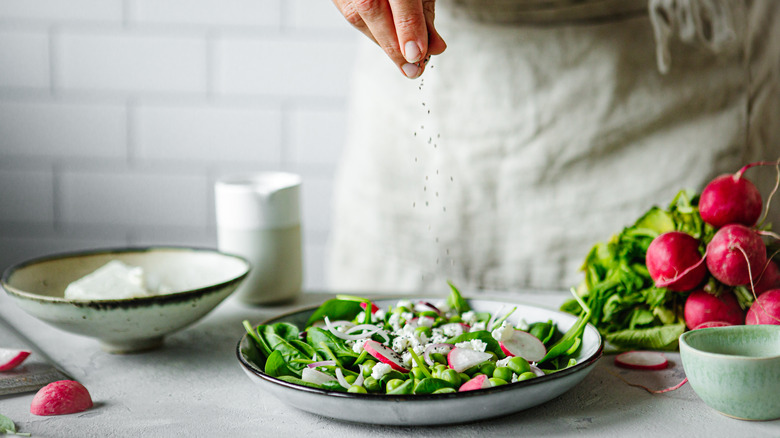How To Store Radishes For Optimal Freshness
Radishes are often overlooked vegetables with some serious versatility. Whether you've been a longtime radish consumer or more recently discovered them during their TikTok debut as the perfect fauxtato (fake potato), these crunchy veggies are worth having on your radar. Since they come in several varieties – including the watermelon, French breakfast, daikon, and others — their flavors range from mild to peppery, meaning most people can find a type to suit their taste.
With myriad flavors come many unique ways to use your radishes, so it's beneficial to understand how to store them properly for optimal freshness. There are a few different storage options to keep these veggies crisp, including storing them in a plastic bag in your refrigerator's crisper drawer, placing them in a jar of water in the refrigerator, or freezing your radishes. You'll want to select your preferred storage method based on when you plan to use your produce — and then follow the storage instructions properly.
If you intend to consume your radishes within five to seven days, you can simply prep them by clipping the stems, removing any visible dirt or debris, and wrapping your clean veggies in a damp paper towel. You're then ready to place them in a plastic food storage bag and into the crisper drawer of your fridge, where they will stay fresh for up to seven days.
Executing longer-term storage methods
Perhaps you plan to take more than a week to use your radishes. In this case, your best storage option is to submerge your whole, cleaned veggies in a jar of cold water before placing them into the refrigerator. First, trim off the roots and leaves, then rinse your radishes clean before placing them in the jar of cold water. Make sure to seal your container tightly to maintain peak freshness. You can then refrigerate your produce for one to two weeks.
If you suddenly find yourself with an abundance of radishes or don't plan to use them anytime soon, freezing them is an option for longer-term storage. Radish-freezing is slightly more involved. It requires you to first clean and destem your veggies. Then, cut them into cubes or halves, and blanch them by boiling quickly (for two to three minutes max) before transferring your produce into ice water and drying them off. Finally, you're ready to place them into freezer bags (removing excess air) and store them in the freezer, where they can chill for at least six months or even a year. However, they won't quite maintain their taste or texture.
Considering that these vegetables are nutritious and have so many different flavors to choose from, there's a good case for eating more radishes. Whether you're planning to enjoy them right away, keep them stored until inspiration strikes to whip up a radish sandwich, or consume them months later, fresh radishes are a great option (with the proper storage techniques).

